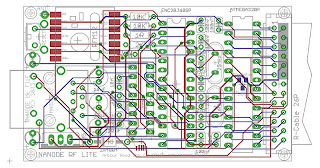Nanode was conceived back in the summer of 2010, when I returned from a trip to Shenzhen, China. I was between jobs, and had a bit of time on my hands for tinkering with some new product ideas.
Nanode arose out of the need to find a cheaper way of connecting simple open source hardware, such as Arduino to the internet, so that Arduino could be used for a range of sensing and control applications.
The combination of an Arduino and a low cost ethernet shield came to approximately £35, and from a quick glance at the Arduino and the ethershield showed that not only could the circuit design be produced on one pcb, but produced at considerably lower cost. So with the breadboarded prototype working, I set about producing a pcb version, which using conventional through-hole components and DIL ICs, could be sold as a kit and assembled by anyone with basic soldering skills.
It was anticipated that the kits could be sold for about £20, and so ten prototypes were made to test out the pcb layout. These first ten Nanode prototype pcbs were produced and sent out to friends and enthusiasts for beta testing and application development.
A pair of Nanode Prototypes - April 2011
From the outset, Nanode was offered as a DIY kit consisting of the pcb, the ICs and some 50 other components. Assembly was fairly straightforward - and an online pictorial build guide was produced to make the assembly process as simple as possible - even for those who had had little or no previous soldering experience.
During the summer months of 2011, 550 Nanode kits were produced in the UK on green pcbs and sold out by the end of August. In September, 500 new red pcbs arrived from China changing the appearance of Nanode somewhat.
The popular Nanode 5 on a red pcb. September 2011
Following a review of the design in the Autumn of 2011, it was clear that the addition of a wireless transceiver link would considerably enhance the capabilities of the device. With a RF module onboard, Nanode could "talk" to other hardware devices such as smart sensors, extending the control and monitoring range to several tens of metres from the ethernet router. RF range tests showed a useful range of better than 125m.
The pcb was updated at the end of October 2011, so that Nanode could benefit from an RFM12 RF transceiver, and thus be compatible with JeeNodes from Jeelabs. In addition to the RF module, an extra 3V3 regulator, a miniUSB socket for power and an extra green LED were added. There were spare locations on the board to which a 32K SRAM, a real time clock and a microSD card could be added to the underside of the pcb.
Nanode RF on an early prototype green pcb.
Following the success of the first prototype above 500 Nanode RF units were produced in China on a distinctive blue pcb.
The last of these Nanode RF kits sold out at the end of October 2012. So from the humble kit beginnings and just 18 months, almost 2000 Nanodes have been produced so far, with production and kitting happening in the UK, USA and China.
500 Nanode RF kits were produced on blue pcb.
Clearly a replacement to the Nanode RF was needed, and this is where our friends at Wicked Device of Ithaca NY, stepped in.
Wicked Device had become Nanode distributors in the USA, and in 2011 had produced their own versions of the kit and pcb.
Following the requirement for a low cost ethernet gateway product for the Air Quality Egg project, Dirk Swart and Vic Aprea at Wicked Device redesigned the Nanode RF so that it utilised surface mount components, and could be mass produced on a pick and place machine. So it's my pleasure to introduce the new Nanode Gateway, the first of the Nanode SMT units, which is being produced at Wicked Device's premises in upstate New York. These units will be available through the Nanode Shop from early November.
The new Nanode Gateway produced by Wicked Device provides a platform for the creative development of web connected devices, and with the use of low power RF, extends this connectivity well beyond the reach of normal WiFi devices.
Nanode Gateway uses low power 433MHz or 868MHz wireless to form a bidirectional link between the internet and remote sensors. Within the home and garden environment the Gateway has a range exceeding 100m. It is available with or without a radio module, which can easily be added later.
The Nanode Gateway allows you to connect sensor networks – for example environmental or weather sensors, to the internet for web based data logging and visualisation. The bidirectional wireless link allows the remote control of devices using relays or actuators providing the means for web controlled home automation.
Now it is possible to connect sensors all around your home and garden back to the internet, and control external devices using a web browser interface.
- Combines Ethernet and low power 433MHz or 868MHz wireless connectivity on an Arduino compatible platform.
- Provides a gateway for low power wireless devices to connect to the internet – with a range exceeding 100m.
- Wireless link allows monitoring and control of remote sensors and devices
- Open Source Hardware and Open Wireless Protocol used throughout.
- ATmega328 microcontroller programmed using Arduino IDE
- Supports up to 30 slave sensors or devices
- Low cost, and expandable using Arduino like shields
- Used in the Air Quality Egg and Open Energy Monitor Projects
- A building block of the Internet of Things
- Manufactured in the USA by Wicked Device.





















